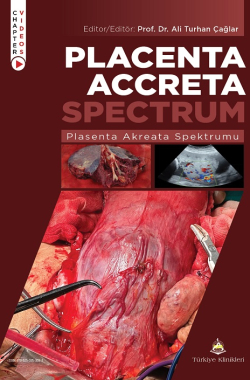Natal Management, Non-Conservative Surgical Managament
Dr. Sadun Sucu1
Prof. Dr. Ali Turhan Çağlar2
1Department of Perinatology, Ankara Etlik City Hospital, Ankara, Türkiye
2Department of Perinatology, Ankara Etlik City Hospital, Ankara, Türkiye
ABSTRACT
Placenta accreta spectrum (PAS) patients are confronted with various problems during pregnancy and child- birth. These problems require follow-up care and treatment in experienced centers. These centers can mini- mize blood loss, the most common consequence, with tranexamic acid infusion, intra-arterial balloon applica- tion or ligation of the hypogastric artery. Although none of these methods are routinely used in the guidelines, they have been shown to be beneficial in many studies. There are no large-scale randomized controlled trials of patients diagnosed with placenta accreta using these methods. The risk of urological injury is high due to the deep penetration of the placenta or the patient’s specific medical history. The bladder can be inflated with 200-300 ml diluted methylene blue and bilateral double-J catheters placed in the ureters to prevent urolog- ical damage. Cystoscopy may reveal bladder invasion during this operation. Following standard surgical an- tibiotic prophylaxis in prenatally diagnosed patients who are scheduled for hysterectomy after preoperative complication prophylaxis, a median incision allows visualization of the uterine incision and invasion of the pla- centa. The baby is delivered after a planned uterine incision without damaging the placenta. No postpartum uterotonic drugs are used and the umbilical cord is cut, ligated and placed in the uterus to suture the incision. The severity of placental invasion should determine the necessary caution in separating the bladder and uter- us. Heavy bleeding may occur during the dissection. A tourniquet can be applied to the uterus with a Foley catheter at the level of the isthmus to reduce the uterine bleeding that may occur during this dissection. The arteries and ligaments of the uterus are clamped, cut and ligated after the bladder has been separated from the uterus. The operation is completed with the formation of a vaginal cuff. In general, a total hysterectomy is performed instead of a sub-total hysterectomy.
Keywords: Placenta accreta spectrum; Hysterectomy; Multidisciplinary health teams; Cesarean section, Repeat; Tranexamic acid; Balloon occlusion; Morbidity
Kaynak Göster
Referanslar
- American College of Obstetricians and Gynecolo- gists, Society for Maternal-Fetal Medicine. Obstetric Care Consensus No. 7: Placenta Accreta Spectrum. Ob- stet Gynecol. 2018;132(6):e259-e275. [Crossref] [PubMed]
- Allen L, Jauniaux E, Hobson S, Papillon-Smith J, Belfort MA, FIGO Placenta Accreta Diagnosis and Management Expert Consensus Panel. FIGO consensus guidelines on pla- centa accreta spectrum disorders: Nonconservative surgical management. Int J Gynaecol Obstet Off Organ Int Fed Gy- naecol Obstet. 2018;140(3):281-290. [Crossref] [PubMed]
- Shellhaas CS, Gilbert S, Landon MB, Varner MW, Lev- eno KJ, Hauth JC, et al. The Frequency and Complication Rates of Hysterectomy Accompanying Cesarean Delivery. Obstet Gynecol. 2009;114(2 Pt 1):224-229. [Crossref] [PubMed]
- Wright JD, Devine P, Shah M, Gaddipati S, Lewin SN, Simpson LL, et al. Morbidity and mortality of peripartum hysterectomy. Obstet Gynecol. 2010;115(6):1187-1193. [Crossref] [PubMed]
- ACOG Practice Bulletin No. 120: Use of prophylactic an- tibiotics in labor and delivery - PubMed. Accessed August 8, 2024. [PubMed]
- Grace Tan SE, Jobling TW, Wallace EM, McNeilage LJ, Manolitsas T, Hodges RJ. Surgical management of pla- centa accreta: a 10-year experience. Acta Obstet Gynecol Scand. 2013;92(4):445-450. [Crossref] [PubMed]
- Woldu SL, Ordonez MA, Devine PC, Wright JD. Urologic considerations of placenta accreta: a contemporary tertia- ry care institutional experience. Urol Int. 2014;93(1):74-79. [Crossref] [PubMed]
- Abbas F, Talati J, Wasti S, Akram S, Ghaffar S, Qureshi R. Placenta percreta with bladder invasion as a cause of life threatening hemorrhage. J Urol. 2000;164(4):1270-1274. [Crossref] [PubMed]
- Shamshirsaz AA, Fox KA, Salmanian B, Diaz-Arrastia CR, Lee W, Baker WB, et al. Maternal morbidity in patients with morbidly adherent placenta treated with and without a standardized multidisciplinary approach. Am J Obstet Gyne- col. 2015;212(2):218.e1-9. [Crossref] [PubMed]
- Al-Khan A, Gupta V, Illsley NP, Mannion C, Koenig C, Bogomol A, et al. Maternal and fetal outcomes in pla- centa accreta after institution of team-managed care. Re- prod Sci Thousand Oaks Calif. 2014;21(6):761-771. [Crossref] [PubMed]
- Norris BL, Everaerts W, Posma E, Murphy DG, Umstad MP, Costello AJ, et al. The urologist's role in multidisciplinary management of placenta percreta. BJU Int. 2016;117(6):961- 965. [Crossref] [PubMed]
- Wright JD, Silver RM, Bonanno C, Gaddipati S, Lu YS, Simp- son LL,et al. Practice patterns and knowledge of obstetricians and gynecologists regarding placenta accreta. J Matern-Fetal Neonatal Med Off J Eur Assoc Perinat Med Fed Asia Ocean Perinat Soc Int Soc Perinat Obstet. 2013;26(16):1602-1609. [Crossref] [PubMed]
- Matsubara S, Kuwata T, Usui R, Watanabe T, Izumi A, Ohku- chi A, et al. Important surgical measures and techniques at cesarean hysterectomy for placenta previa accreta. Acta Obstet Gynecol Scand. 2013;92(4):372-377. [Crossref] [PubMed]
- Jauniaux E, Alfirevic Z, Bhide AG, Belfort MA, Burton GJ, Collins SL, et al. Placenta Praevia and Placenta Accre- ta: Diagnosis and Management: Green-top Guideline No. 27a. BJOG Int J Obstet Gynaecol. 2019;126(1):e1-e48. [Crossref] [PubMed]
- Jolley JA, Nageotte MP, Wing DA, Shrivastava VK. Manage-ment of placenta accreta: a survey of Maternal-Fetal Medi- cine practitioners. J Matern-Fetal Neonatal Med Off J Eur Assoc Perinat Med Fed Asia Ocean Perinat Soc Int Soc Peri- nat Obstet. 2012;25(6):756-760. [Crossref] [PubMed]
- Tam Tam KB, Dozier J, Martin JN. Approaches to reduce urinary tract injury during management of placenta accreta, increta, and percreta: a systematic review. J Matern-Fetal Neonatal Med Off J Eur Assoc Perinat Med Fed Asia Ocean Perinat Soc Int Soc Perinat Obstet. 2012;25(4):329-334. do i:10.3109/14767058.2011.576720 https://pubmed.ncbi.nlm. nih.gov/23003574/ https://www.tandfonline.com/doi/full/10. 3109/14767058.2011.576720 [Crossref]
- Clausen C, Stensballe J, Albrechtsen CK, Hansen MA, Lönn L, Langhoff-Roos J. Balloon occlusion of the internal iliac arteries in the multidisciplinary management of placenta percreta. Acta Obstet Gynecol Scand. 2013;92(4):386-391. [Crossref] [PubMed]
- Sentilhes L, Goffinet F, Kayem G. Management of placen- ta accreta. Acta Obstet Gynecol Scand. 2013;92(10):1125- 1134. [Crossref] [PubMed]
- Sewell MF, Rosenblum D, Ehrenberg H. Arterial embolus during common iliac balloon catheterization at cesarean hysterectomy. Obstet Gynecol. 2006;108(3 Pt 2):746-748. [Crossref] [PubMed]
- Gagnon J, Boucher L, Kaufman I, Brown R, Moore A. Il- iac artery rupture related to balloon insertion for placenta accreta causing maternal hemorrhage and neonatal compro- mise. Can J Anaesth J Can Anesth. 2013;60(12):1212-1217. [Crossref] [PubMed]
- Bishop S, Butler K, Monaghan S, Chan K, Murphy G, Edoz- ien L. Multiple complications following the use of prophy- lactic internal iliac artery balloon catheterisation in a patient with placenta percreta. Int J Obstet Anesth. 2011;20(1):70-73. [Crossref] [PubMed]
- Shakur H, Roberts I, Fawole B, Chaudhri R, El-Sheikh M, Akintanet A, et al. Effect of early tranexamic acid adminis- tration on mortality, hysterectomy, and other morbidities in women with post-partum haemorrhage (WOMAN): an in- ternational, randomised, double-blind, placebo-controlled trial. The Lancet. 2017;389(10084):2105-2116. [Crossref] [PubMed]
- Simonazzi G, Bisulli M, Saccone G, Moro E, Marshall A, Berghella V. Tranexamic acid for preventing postpartum blood loss after cesarean delivery: a systematic review and meta-analysis of randomized controlled trials. Acta Obstet Gynecol Scand. 2016;95(1):28-37. [Crossref] [PubMed]
- Franchini M, Lippi G, Franchi M. The use of recombinant activated factor VII in obstetric and gynaecological haem- orrhage. BJOG Int J Obstet Gynaecol. 2007;114(1):8-15. [Crossref] [PubMed]
- Levi M, Levy JH, Andersen HF, Truloff D. Safety of recom- binant activated factor VII in randomized clinical trials. N Engl J Med. 2010;363(19):1791-1800. [Crossref] [PubMed]
- Camuzcuoglu A, Vural M, Hilali NG, Incebiyik A, Yuce HH, Kucuk A, et al. Surgical management of 58 patients with pla- centa praevia percreta. Wien Klin Wochenschr. 2016;128(9- 10):360-366. [Crossref] [PubMed]
- Walker MG, Pollard L, Talati C, Carvalho JCA, Allen LM, Kachura J, et al. Obstetric and Anaesthesia Checklists for the Management of Morbidly Adherent Placenta. J Ob- stet Gynaecol Can JOGC J Obstet Gynecol Can JOGC. 2016;38(11):1015-1023. [Crossref] [PubMed]
- Esakoff TF, Handler SJ, Granados JM, Caughey AB. PAMUS: placenta accreta management across the United States. J Matern-Fetal Neonatal Med Off J Eur Assoc Peri- nat Med Fed Asia Ocean Perinat Soc Int Soc Perinat Obstet. 2012;25(6):761-765. [Crossref] [PubMed]


